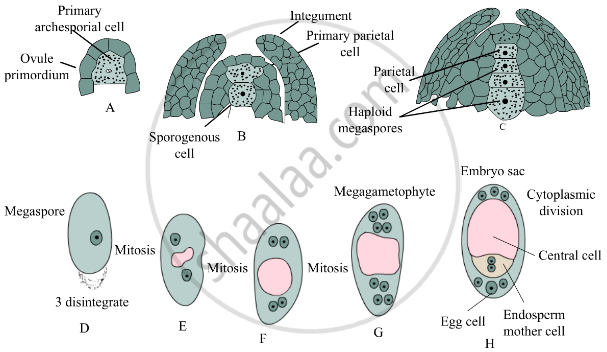Advertisements
Advertisements
प्रश्न
Answer the following question.
Where does the process of megasporogenis start in an angiosperm? Describe the process up to the formation of an embryo sac.
उत्तर
Megasporogenesis is the process of formation of megaspores from megaspore mother cells (MMC). The megaspore mother cell (MMC) undergoes meiosis and forms a linear tetrad of 4 haploid megaspores. The process of meiotic formation of haploid megaspores from diploid megaspore mother cell is called megasporogenesis. Commonly the chalazal megaspore remains functional while the other 3 degenerates.
The functional megaspore is the first cell of the female gametophyte. The cell enlarges and undergoes three free nuclear mitotic divisions. The first division produces two nucleate embryo sac. The two nuclei shift to the two ends and divide there twice forming four nucleate and then eight nucleate structures.
One nucleus from each side moves to the middle. They are called polar nuclei. The remaining three nuclei from cells at the two ends, 3 celled egg apparatus at the micropylar end and three antipodal cells at the chalazal end.
The middle bi-nucleate part organizes itself into a central cell. Embryo sac developed from a single megaspore is called monosporic.
APPEARS IN
संबंधित प्रश्न
Differentiate between integument and testa.
Where exactly is the filiform apparatus present in the embryo sac of an angiosperm? States its function.
Name the hormones influencing the follicular development of corpus luteum.
Ovule is straight with funiculus, embryo sac, chalaza, and micropyle lying on one straight line. It is ______.
An embryo may sometimes develop from any cell of embryo sac other than egg. It is termed as ______.
Megasporangium along with its protective integuments is called ______.
Mark the odd one.
In the figure of anatropous ovule given below, choose the correct option for the characteristic distribution of cells within the typical embryo sac

| Number of cells at the chalazal end | Number of cells at micropylar end | Number of nuclei left in the central cell | |
| A | 3 | 2 | 3 |
| B | 3 | 3 | 2 |
| C | 2 | 3 | 3 |
| D | 2 | 2 | 4 |
The hilum is a scar on the:
Filiform apparatus is a characteristic feature of ______.
